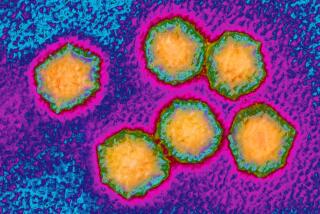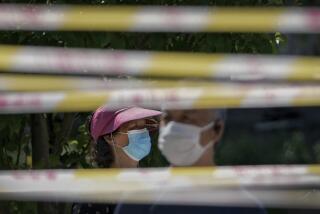Shanghai Fears Worsening of Hepatitis
- Share via
BEIJING — Health officials in Shanghai fear that an epidemic of hepatitis-A that broke out last month may worsen in the next few weeks, the official China Daily reported Wednesday.
The epidemic, believed to have been caused by contaminated clams, “has passed its first peak,” the newspaper said, “but a second peak, resulting from cases of people infected by the first victims of the epidemic, is expected to come in a week.”
Officials in Shanghai, a city of 12 million people, have said that about 16,000 people are infected with the viral disease. Estimates circulating among Western diplomatic sources put the number at 40,000 to 60,000.
“Everyone in Shanghai now takes it very seriously,” Liu Kejun, a spokesman for the Shanghai Health Bureau, said in a telephone interview.
“We have put a lot of effort into a campaign to warn people against this disease. We warn people to wash their hands, to be very careful when eating in restaurants, and we warn the restaurants to sterilize everything they use. There are posters at hotels, restaurants, public baths, the railway station and factory dining halls.”
U.S. consular offices in China and the State Department in Washington have issued travel advisories warning visitors to Shanghai not to drink untreated water or eat raw foods, especially shellfish and salads. Inoculations of gamma globulin, which contains antibodies against the disease, are recommended.
Hepatitis-A is an infectious liver inflammation, spread by contaminated food and water, that causes flu-like symptoms such as fever, vomiting and fatigue. Although seldom fatal, it is a debilitating illness that is common in countries with poor sanitation. The precautions recommended by the State Department are standard for travel in most developing countries.
25,000 Beds Added
The incidence of hepatitis-A in Shanghai is 20 times higher than normal, according to the China Daily. Local medical departments have set up an additional 25,000 beds to accommodate hepatitis cases, the newspaper reported.
Liu said that local hospitals are unable to care for all those who have been stricken but that health authorities want to isolate patients rather than having them return home ill.
“The government has called for assistance from other units, including medical institutes,” he said. “Every hospital that can add more beds should help solve the problem. And some new apartment buildings that have been completed but not yet occupied are being used to put up patients.”
Factory clinics and some schools are also being used, according to other Shanghai officials.
Liu said that students and faculty at medical schools in Shanghai, as well as medical students from Shanghai who are home on vacation from school in other cities, have been enlisted to help care for the ill. Patients are being treated with a traditional Chinese medicine, he said.
Clams from heavily polluted coastal waters that were sold in city markets in December were responsible for the epidemic, Liu said. About 90% of the patients treated in the last three weeks had eaten the clams, he said.
Tests have shown that the clams were contaminated with the virus.
“Shanghai people like to eat clams after just pouring some boiling water over them,” Liu said. But this is not enough to kill the virus, and the sale of clams in Shanghai has now been banned, he said. More than 15 tons of clams have been destroyed, according to the China Daily report.
Public health and sanitation in China is at a higher level than in many developing countries, but the way sewage is dealt with in Shanghai, and in most of the country, falls short of Western standards. This makes the eradication of diseases such as hepatitis-A extremely difficult.
The number of hepatitis-A cases normally rises at this time of year, but the last significant outbreak in Shanghai was in 1982, Liu said.
More to Read
Sign up for Essential California
The most important California stories and recommendations in your inbox every morning.
You may occasionally receive promotional content from the Los Angeles Times.













